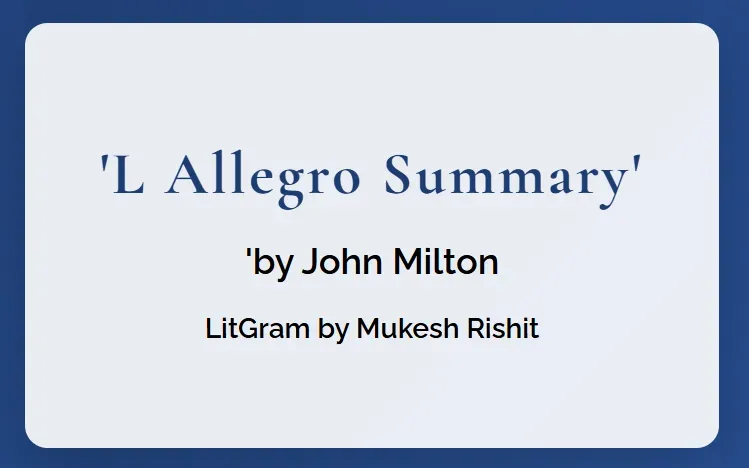John Milton’s “L Allegro” stands as one of the most vibrant and joyful poems in English literature. This companion piece to “Il Penseroso” invites readers into a world of merriment, countryside pleasures, and the carefree spirit of youth. Written during Milton’s early career around 1631, this poem celebrates the cheerful life and showcases Milton’s extraordinary command of imagery and classical allusions.
The Historical Context of L Allegro
Milton’s Early Career and Influences
“L’Allegro” was composed during Milton’s formative years as a poet, before the political turmoil that would later define his life and major works like “Paradise Lost.” During this period, Milton was still exploring his poetic voice, drawing heavily from classical traditions while establishing his unique style.
The Companion Poems
“L’Allegro” (meaning “the happy man” in Italian) was written as a companion to “Il Penseroso” (“the thoughtful man”). Together, these poems present contrasting yet complementary perspectives on human experience—one celebrating joy and sociability, the other contemplation and solitude.
Renaissance Pastoral Tradition
Milton’s poem fits within the pastoral tradition popular during the Renaissance, which idealized rural life and natural settings. However, Milton elevates this tradition by infusing it with sophisticated classical references and complex rhythmic patterns.
Structure and Form of L’Allegro
Metrical Pattern and Rhythm
Milton crafts “L’Allegro” using a varied metrical pattern that shifts between iambic tetrameter and pentameter, creating a lively, dance-like rhythm that mirrors the poem’s celebratory themes:
“Haste thee, Nymph, and bring with thee Jest, and youthful Jollity, Quips, and cranks, and wanton wiles, Nods, and becks, and wreathèd smiles…”
Invocation and Narrative Flow
The poem begins with an invocation banishing melancholy and calling forth Euphrosyne (Mirth), followed by a narrative that traces the pleasures of the cheerful man from morning until night.
Classical and Mythological References
Milton weaves numerous classical allusions throughout the poem, demonstrating his extensive knowledge of Greek and Roman mythology. The poem introduces figures like Euphrosyne (Joy), Venus, Bacchus, and Zephyr, enriching the text with layers of meaning.
Key Themes and Imagery in L’Allegro
Celebration of Pastoral Life
Milton paints vivid pictures of country life, from the crowing cock and “cottage chimney” to the “upland hamlets” and rural festivities. These images glorify the simple pleasures of countryside existence:
“To hear the lark begin his flight, And singing startle the dull night, From his watch-tower in the skies, Till the dappled dawn doth rise…”
The Progression from Dawn to Dusk
The poem follows a day’s journey from sunrise to evening, tracing different pleasures associated with different times of day:
| Time of Day | Activities and Pleasures |
|---|---|
| Morning | Hearing the lark, watching the rising sun, observing countryside labor |
| Midday | Walking through meadows, watching shepherds and farm activities |
| Evening | Social gatherings, stories by the fire, music, dancing |
| Night | Urban pleasures, theater, music, festive city life |
Joy Through Social Connection
Unlike “Il Penseroso,” which celebrates solitude, “L’Allegro” finds delight in social connections—village festivities, tales told around fires, dances, music, and communal celebrations.
Appreciation of Art and Culture
The poem’s later sections transition to more sophisticated pleasures, including theater, music, and poetry. Milton references mythological marriages, comedies by Jonson and Shakespeare, and the enchanting power of music.
Literary Devices in L’Allegro
Personification and Apostrophe
Milton begins by addressing Melancholy as “loathèd Melancholy” and later calls to the “goddess fair and free” of Mirth. These direct addresses bring abstract concepts to life as characters in the poem.
Sensory Imagery ⬇️
The poem engages all senses, from the visual (“dappled dawn”) to the auditory (“soft Lydian airs”) to create an immersive experience of joy:
- Visual: “meadows trim with daisies pied”
- Auditory: “the lark begin his flight”
- Tactile: “on the light fantastic toe”
Alliteration and Assonance
Milton employs these sound devices to enhance the musical quality of his verse:
- “Through the sweetbriar or the vine”
- “Straight mine eye hath caught new pleasures”
Contrasting Imagery
Throughout “L’Allegro,” Milton creates contrasts with the melancholic mood he banishes at the beginning, emphasizing the brightness, movement, and liveliness of the cheerful life.
L’Allegro vs. Il Penseroso: A Comparison
Contrasting Perspectives
These companion poems represent different approaches to life and happiness. “L’Allegro” embraces external pleasures and social activity, while “Il Penseroso” values introspection and contemplation.
Balanced Presentation
Milton gives equal weight to both perspectives, suggesting that both the active and contemplative lives have value. Neither poem dismisses the other’s viewpoint entirely.
Recurring Motifs
Both poems use similar structures, including invocations, the progression from dawn to night, and references to mythology, but direct them toward different emotional states.
Relevance of L’Allegro to Modern Readers
The Search for Balance
Modern readers can relate to Milton’s exploration of balance between social engagement and personal reflection, especially in our hyperconnected digital age where finding such balance is increasingly challenging.
Appreciation of Simple Pleasures
In an era of constant distraction, “L’Allegro” reminds us of the joy found in simple experiences—nature, community, music, and storytelling.
Literary Influence
Milton’s techniques in “L’Allegro” continue to influence contemporary poetry. His skillful blending of classical allusions with accessible imagery and his masterful control of rhythm and sound demonstrate principles still valued in poetry today.
How to Read and Understand L’Allegro
Tips for First-Time Readers ⬇️
Reading Milton can be challenging due to his complex syntax and classical references. Here are strategies for approaching “L’Allegro”:
- Read aloud to appreciate the musical qualities
- Look up unfamiliar mythological references
- Pay attention to the progression of time throughout the poem
- Compare with “Il Penseroso” for deeper understanding
Key Passages for Analysis
Several passages deserve special attention for their technical brilliance and thematic importance:
- The opening invocation banishing Melancholy
- The description of morning (lines 41-68)
- The village festivities (lines 91-116)
- The references to theater and music (lines 131-150)
Questions for Deeper Reflection
- How does Milton’s depiction of joy differ from modern conceptions?
- What role does nature play in the speaker’s experience of happiness?
- How do the classical allusions enhance the poem’s themes?
Key Takeaways
- “L’Allegro” celebrates active, joyful engagement with the world through Milton’s masterful poetic techniques.
- The poem presents a sequence of pleasures from dawn to night, moving from rural to more sophisticated urban delights.
- As a companion to “Il Penseroso,” it offers one side of a balanced approach to life, suggesting that joy and contemplation are complementary rather than opposing forces.
- Milton’s command of rhythm, imagery, and classical allusion creates a rich, multi-layered reading experience.
- The poem remains relevant for its exploration of how to find joy and meaning in both natural and cultural experiences.
FAQ About L’Allegro
What does “L’Allegro” mean?
“L’Allegro” comes from Italian and means “the cheerful one” or “the happy man.” The title immediately establishes the poem’s focus on joy and mirth.
Who is Euphrosyne in the poem?
Euphrosyne is one of the three Graces in Greek mythology and represents mirth or joy. Milton invokes her as the goddess of cheerfulness and the central figure of the poem.
How does L’Allegro differ from Il Penseroso?
While “L’Allegro” celebrates social joy, daylight activities, and external pleasures, “Il Penseroso” honors contemplation, night, solitude, and internal experiences. They present complementary rather than opposing lifestyles.
Why did Milton write these companion poems?
Milton likely wrote these poems to explore the complementary nature of different temperaments and approaches to life. They demonstrate his versatility as a poet and his interest in classical ideas about balanced living.
What makes L’Allegro significant in Milton’s body of work?
Though less famous than “Paradise Lost,” “L’Allegro” showcases Milton’s early mastery of lyric poetry and his ability to create vivid imagery. It also reveals a lighter side of a poet often associated with more serious religious and political themes.
Conclusion: The Enduring Appeal of L’Allegro
“L’Allegro” continues to captivate readers with its vibrant celebration of joy, its masterful poetic techniques, and its timeless exploration of what makes life worth living. Milton’s ability to transform classical influences into accessible yet profound poetry demonstrates why he remains one of English literature’s most respected figures.
Through this cheerful counterpart to the more contemplative “Il Penseroso,” Milton reminds us that a fulfilling life embraces both social pleasure and thoughtful solitude. Modern readers can still find resonance in his portrayal of simple joys—from sunrise over meadows to evenings filled with music and story—even as we navigate a world vastly different from Milton’s 17th-century England.
What aspects of “L’Allegro” speak to you most powerfully? Perhaps it’s time to experience this celebration of joy for yourself, and discover why Milton’s lyric masterpiece has endured for nearly four centuries.
Looking for more classic poetry analysis? Explore our discussions of Wandering Singers by Sarojini Naidu or To a Snowdrop by William Wordsworth to deepen your appreciation of English poetry.


